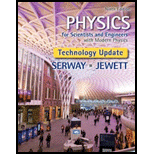
The coefficient of performance of refrigerator from second law of
Answer to Problem 1OQ
Option (d), finite.
Explanation of Solution
Second law of thermodynamics states that external work is necessary to pump heat from lower temperature to higher temperature. A refrigerator takes energy from cold reservoir and expels at hot reservoir. Refrigerator has to do work to convert heat from cold reservoir to hot reservoir. Coefficient of performance is the ratio of heat extracted from cold reservoir to work done on the refrigerant.
The maximum efficiency of a refrigerator is possible if it is working in Carnot cycle. The expression for efficiency is
Conclusion:
Therefore, according to second law of thermodynamics the coefficient of performance of a refrigerator must be finite. Thus, option (d) is correct.
Since coefficient of performance of refrigerator can be greater than 1, option (a) is incorrect.
Since coefficient of performance of refrigerator can be greater than 1, option (b) is incorrect.
Since coefficient of performance of refrigerator can be greater than or less than 1, option (c) is correct.
Since coefficient of performance of refrigerator can be zero, option (e) is incorrect.
Want to see more full solutions like this?
Chapter 22 Solutions
Physics for Scientists and Engineers with Modern Physics, Technology Update
- A thermodynamic process occurs in which the entropy of a system changes by -8 J/K. According to the second law of thermodynamics, what can you conclude about the entropy change of the environment? It must be +8 J/K or less. It must be between +8 J/K and 0. It must be equal to +8 J/K. It must be +8 J/K or more. It must be zero.arrow_forwardThe entropy of a system is a measure of the dispersal of matter and energy among the molecules in microstates. True Falsearrow_forwardA refrigerator has a coefficient of performance of 3.0. (a) If it requires 200 J of work per cycle, how much heat per cycle does it remove the cold reservoir? (b) How much heat per cycle is discarded to the hot reservoir?arrow_forward
- (a) How much heat transfer occurs to the environment by an electrical power station that uses 1.25×1014 J of heat transfer into the engine with an efficiency of 42.0%? (b) What is the ratio of heat transfer to the environment to work output? (c) How much work is done?arrow_forwardThe efficiency of a refrigerator increases by 3 percent for each °C rise in the minimum temperature in the device. What is the increase in the efficiency for each (a) K, (b) °F, and (c) R rise in temperature?arrow_forward(a) How much heat transfer occurs to the environment by an electrical power station that uses 1.25 × 1014 J of heat transfer into the engine with an efficiency of 42.0%? (b) What is the ratio of heat transfer to the environment to work output? (c) How much work is done?arrow_forward
- A box contains 100 atoms in a configuration that has 50 atoms in each half of the box. Suppose that you could count the different microstates associated with this configuration at the rate of 100 billion states per second, using a supercomputer. Without written calculation, guess how much computing time you would need: a day, a year, or much more than a year.arrow_forwarda) According to the First Law of Thermodynamics, how much did the thermal energy of a system change if we did 1500 J of work on the system, while the system lost 750 J of heat to the environment? b) A heat engine extracts 55 kJ from the hot reservoir and exhausts 40 kJ into the cold reservoir. How much work was done and what is the efficiency, e?arrow_forwardA heat engine operates between a high temperature of about 600°C and a low temperature of about 300°C. What is the maximum theoretical efficiency for this engine? (a) = 100%. (e) Cannot be determined from the given information. (b) - 66%. (c)~ 50%. (d) ~ 34%.arrow_forward
- The second law of thermodynamics is a statement that entropy increases during a process. This applies to spontaneous processes in a system with no energy exchange with the outside. any spontaneous processes. any process in a system with no energy exchange with the outside. any process whatsoever.arrow_forward= The latent heat of vaporization of water is given approximately by Lv = -2,400TC + 2,500,000, where Tc is the temperature in Celsius of the water, and L is in J/kg. A puddle of 2.8 kg of water at temperature 13°C evaporates in a room having temperature 27°C. Calculate the change in entropy of the universe during this process, assuming the water and room don't change temperature significantly during the evaporation process. 486 1,127.9366 margin of error +/- 1%arrow_forwardThe first law of thermodynamics states that the change AU in the internal energy of a system is given by AU = Q - W where Q is the heat, and W is the work. Both Q and W can be positive or negative numbers. Q is a positive number if and W is a positive number ifarrow_forward
 Principles of Physics: A Calculus-Based TextPhysicsISBN:9781133104261Author:Raymond A. Serway, John W. JewettPublisher:Cengage Learning
Principles of Physics: A Calculus-Based TextPhysicsISBN:9781133104261Author:Raymond A. Serway, John W. JewettPublisher:Cengage Learning Physics for Scientists and Engineers, Technology ...PhysicsISBN:9781305116399Author:Raymond A. Serway, John W. JewettPublisher:Cengage Learning
Physics for Scientists and Engineers, Technology ...PhysicsISBN:9781305116399Author:Raymond A. Serway, John W. JewettPublisher:Cengage Learning College PhysicsPhysicsISBN:9781938168000Author:Paul Peter Urone, Roger HinrichsPublisher:OpenStax College
College PhysicsPhysicsISBN:9781938168000Author:Paul Peter Urone, Roger HinrichsPublisher:OpenStax College



